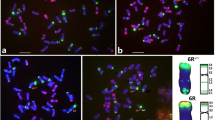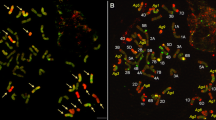Abstract
Two amphiploids, AF-1(Triticum aestivum L. cv. Anyuepaideng–Secale africanum Stapf.) and BF-1 (T. turgidum ssp. carthlicum–S. africanum), were evaluated by chromosomal banding and in situ hybridization. The individual S. africanum chromosomes were identified in the BF-1 background by sequential C-banding and genomic in situ hybridization (GISH), and were distinguishable from those of S. cereale, because they exhibited less terminal heterochromatin. Fluorescence in situ hybridization (FISH) using the tandem repeat pSc250 as a probe indicated that only 6Ra of S. africanum contained a significant hybrid signal, whereas S. cereale displayed strong hybridization at the telomeres or subtelomeres in all seven pairs of chromosomes. Extensive wheat–S. africanum non-Robertsonian translocations were observed in both AF-1 and BF-1 plants, suggesting a frequent occurrence of chromosomal recombination between wheat and S. africanum. Moreover, introgression lines selected from the progeny of wheat/AF-1 crosses were resistant when field tested with widely virulent strains of Puccinia striiformis f. sp. tritici. Three highly resistant lines were selected. GISH and C-banding revealed that resistant line L9-15 carried a pair of 1BL.1RS translocated chromosomes. This new type of S. africanum derived wheat–Secale translocation line with resistance to Yr9-virulent strains will broaden the genetic diversity of 1BL.1RS for wheat breeding.



Similar content being viewed by others
References
Bennett MD, Gustafson JP, Smith JB (1977) Variation in nuclear DNA in the genus Secale. Chromosoma 61:149–176. doi:10.1007/BF00327398
Cheng ZJ, Murata M (2002) Loss of chromosomes 2R and 5RS in octaploid triticale selected for agronomic traits. Genes Genet Syst 77:23–29. doi:10.1266/ggs.77.23
Cuadrade A, Jouve N (1995) Fluorescent in situ hybridization and C-banding analyses of highly repetitive DNA sequences in the heterochromatin of rye (Secale montanum Guss.) and wheat incorporating S. montanum chromosome segments. Genome 38:796–802
Gill BS, Friebe B, Endo TR (1991) Standard karyotype and nomenclature system for description of chromosome bands and structural aberrations in wheat (Triticum aestivum). Genome 34:830–839
Hammer K, Khoshbakht K (2005) Towards a ‘red list’ for crop plant species. Genet Resour Crop Evol 52:249–265. doi:10.1007/s10722-004-7550-6
Jiang HR, Dai DQ, Xiao SH (1992) Production of wheat special germplasm. J Sichuan Agric Univ 10:255–259 (in Chinese)
Jiang J, Friebe B, Gill BS (1994) Recent advances in alien gene transfer in wheat. Euphytica 73:199–212. doi:10.1007/BF00036700
Jouve N, Soler C (1996) Triticale genomic and chromosomes’ history. In: Gudes-Pinto H, Darvey N, Carnide VP (eds) Triticale: Today and Tomorrow. Kluwer Academic Publishers, The Netherlands, pp 91–118
Ko JM, Seo BB, Suh DY, Do GS, Park DS, Kwack YH (2002) Production of a new wheat line possessing the 1BL.1RS wheat-rye translocation derived from Korean rye cultivar Paldanghomil. Theor Appl Genet 104:171–176. doi:10.1007/s00122-001-0783-2
Li ZF, Xia XC, Zhou XC, Niu YC, He ZH, Zhang Y, Li GQ, Wan AM, Wang DS, Chen XM, Lu QL, Singh R (2006) Seedling and slow rusting resistance to stripe rust in Chinese common wheats. Plant Dis 90:1302–1312. doi:10.1094/PD-90-1302
Lukaszewski AJ, Gustafson JP (1987) Cytogenetics of triticale. In: Janick J (ed) Plant Breeding Reviews, vol 5. AVI Publishing, NY, pp 41–93
Luo PG, Zhang HY, Shu K, Zhang HQ, Luo HY, Ren ZL (2008) Diversity of stripe rust (Puccinia striiformis f. sp. tritici) resistance in wheat genotype with 1RS chromosomal translocations from different rye lines. Can J Plant Pathol 30:254–259
Mago R, Spielmeyer W, Lawrence GJ, Lagudah ES, Ellis JG, Pryor A (2002) Identification and mapping of molecular markers linked to rust resistance genes located on chromosome 1RS of rye using wheat-rye translocation lines. Theor Appl Genet 104:1317–1324. doi:10.1007/s00122-002-0879-3
Miller TE (1973) Alien chromosome additions and substitutions. In: Annu Rep Plant Breed Inst, Cambridge, pp 143
Montero M, Sanz J, Jouve N (1986) Meiotic pairing and alpha-amylase phenotype in a 5B/5Rm Triticum aestivum-Secale montanum translocation line in common wheat. Theor Appl Genet 73:122–128. doi:10.1007/BF00273728
Mukai Y, Friebe B, Gill BS (1992) Comparison of C band pattern and in situ hybridization sites using high repetitive sequences and total genomic rye DNA probes of ‘Imperial’ rye chromosomes added to ‘Chinese Spring’ wheat. Jpn J Genet 67:71–83. doi:10.1266/jjg.67.71
Rabinovich SV (1998) Importance of wheat-rye translocations for breeding modern cultivars of Triticum aestivum L. Euphytica 100:323–340. doi:10.1023/A:1018361819215
Ren ZL, Lelley T, Robbelen G (1991) Transmission of the wheat and rye chromosomes in octoploid triticale x common wheat. Chin J Genet 18:161–167 (in Chinese)
Schlegel R, Korzun V (1997) About the origin of 1RS.1BL wheat-rye chromosome translocations from Germany. Plant Breed 116:537–540. doi:10.1111/j.1439-0523.1997.tb02186.x
Sharma HC, Gill BS (1983) Current status of wide hybridization in wheat. Euphytica 32:17–31. doi:10.1007/BF00036860
Vershinin AV, Schwarzacher T, Heslop-Harrison JS (1995) The large-scale organization of repetitive DNA families at the telomeres of rye chromosomes. Plant Cell 7:1823–1833
Villareal RL, Mujeeb-Kazi A, Rajaram S, Toro ED (1994) Associated effects of chromosome 1B/1R translocation on agronomic traits in hexaploid wheat. Breed Sci 44:7–11
Yang ZJ, Li GR, Ren ZL (2000) Identification of amphiploid between Triticum durum cv. Ailanmai native to Sichuan, China. and Secale africanum. Wheat Inf Serv 91:20–24
Yang ZJ, Li GR, Ren ZL (2001a) Identification of Triticum durum–Secale africanum amphiploid and its crossability with common wheat. J Genet Breed 55:45–50
Yang ZJ, Li GR, Jiang HR, Ren ZL (2001b) Expression of nucleolus, endosperm storage proteins and disease resistance in an amphiploid between Aegilops tauschii and Secale silvestre. Euphytica 119:317–321. doi:10.1023/A:1017591519520
Acknowledgments
We thank the National Natural Science Foundation of China (No. 30671288, 30871518), Program for New Century Excellent Talents in Universities (NCET-06-0810) and Young Scholars Foundation from the Science and Technology Committee of Sichuan (2008-31-371) for financial support. We particularly thank Kathleen Ross (USDA-ARS, University of Missouri, USA) for her helpful comments on the manuscript.
Author information
Authors and Affiliations
Corresponding author
Rights and permissions
About this article
Cite this article
Yang, ZJ., Li, GR., Jia, JQ. et al. Molecular cytogenetic characterization of wheat–Secale africanum amphiploids and derived introgression lines with stripe rust resistance. Euphytica 167, 197–202 (2009). https://doi.org/10.1007/s10681-008-9861-8
Received:
Accepted:
Published:
Issue Date:
DOI: https://doi.org/10.1007/s10681-008-9861-8




